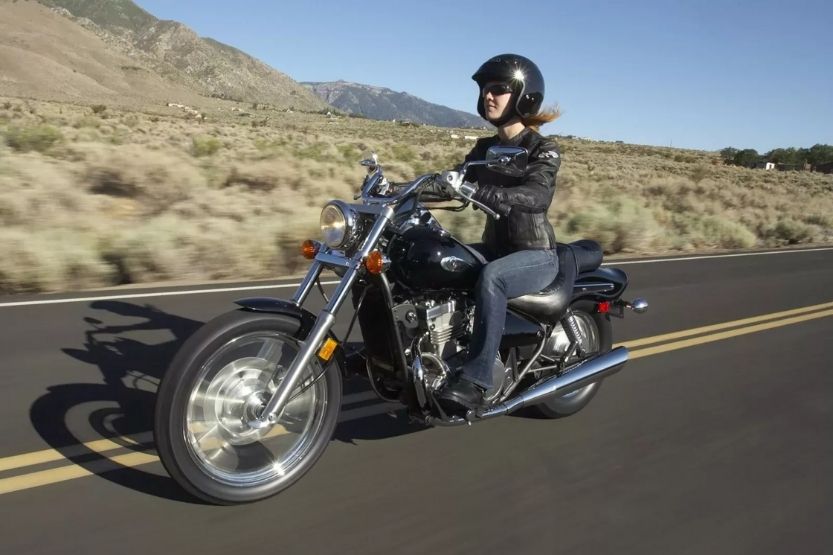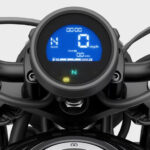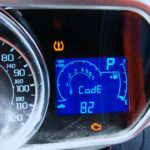The Kawasaki Vulcan 500 may look intimidating initially, but it is one of the best cruiser motorcycles for beginners. It has a comfortable riding style and is light enough to maneuver the bike through traffic with ease. In this Kawasaki Vulcan 500 review, I’ll describe all of its specs and features so you can decide if it is the right bike for you.
The Vulcan 500 mainly gets its power from a 4-valve, 4-stroke, liquid-cooled DOHC Parallel Twin engine with a 498cc displacement. It is the perfect big bike for beginners with a 28.1-inch seat height, swept-back handlebars, and 439 pounds of dry weight.
Read on to learn more about the Kawasaki Vulcan 500, including its specifications and features.
About the Kawasaki Vulcan 500

The Kawasaki Vulcan 500 was not the first to come out in its model line. The first Kawasaki Vulcan was significantly more powerful.
In 1985, Kawasaki introduced the Vulcan VN700A. It was the first cruiser-style bike that used the company’s first-ever V-twin engine and a drive shaft. Initially, Kawasaki had to limit its engine sizes to avoid US tariffs on imported motorcycles 700cc and above.
It is the reason why Vulcan’s first introduction to the US was 699cc. Eventually, the tariff was lifted, thus allowing the importation of the Vulcan 750 series of motorcycles.
In 1986, Kawasaki released the Vulcan 400 series. It was an entry-level cruiser bike with a 399cc liquid-cooled engine similar to the Vulcan 740 series design. It shared a similar design with the 750 series.
1990 was the year that Kawasaki introduced the Vulcan 500. This model used the same engine as the iconic Kawasaki Ninja 500R, a parallel twin 498cc engine.
Although not as powerful as the 750 series, the Vulcan 500, and consequently the Vulcan 500 LTD, Kawasaki had slightly lower compression pistons. This gives the bike a lot more low-end torque. Also, the Vulcan 500 has upgraded ergonomics compared to the previous models.
The Vulcan 500 and 500LTD were in production for almost 20 years when Kawasaki decided to pull the plug on the bike model in 2009. However, since it was quite a huge seller, you will have no trouble finding a secondhand Vulcan 500 in good condition for a reasonable price.
Kawasaki Vulcan 500 Engine
1. Parallel Twin, 4-stroke, Liquid-cooled Engine
The Vulcan 500 came with a parallel twin, 4-stroke, liquid-cooled engine that has a 498cc displacement. This engine is based on the one in the people’s favorite Ninja 500R. With that, you have a guarantee that the input lag and power delivery will be beginner-friendly.
2. Warm-blooded Engine
Another nice thing about the Vulcan 500 is that it is a “warm-blooded” machine. This means you will not have any problems starting this bike, even on cold mornings.
3. 6-speed Manual Transmission
The Vulcan 500 also has a 6-speed manual transmission and chain drive that brings all the power to the rear wheel. Speaking of the wheels, the front uses a 100/90 R19, and the rear is a wide 140/90 R15. The wide rear wheel allows the bike to grip onto the pavement.
4. Average of 48.7 Miles per Gallon
When it comes to fuel economy, you can get an average of 48.7 miles per gallon. You can expect that if the bike is well-maintained and with proper riding habits. Meanwhile, even if it dips slightly, the Vulcan 500 still gets significantly better fuel mileage than other big bikes.
Vulcan 500 Ergonomics
1. Convenient Saddle Height
Many first-time riders will find that the Kawasaki Vulcan 500 specifications may be the perfect fit for them, literally. If you find it difficult to stand on your tip-toes all the time at traffic lights, the Vulcan and its 27-inch saddle height is a more convenient choice.
2. Swept-back Handlebars
Moreover, the swept-back handlebars and the forward foot controls put you into a neutral rider’s triangle, which is the most comfortable riding position. The handlebars are also positioned not to be putting a lot of weight on your wrists. This can reduce fatigue when you go on long rides.
3. Nice Seat with Padding
The seat also has nice padding. It has just the right width to put you in a comfortable seating position. Also, as mentioned earlier, the seat height is enough that even if you are around 5’5” or so, you can still plant your feet flat on the ground when the light turns red on you.
Kawasaki Vulcan 500 Handling
1. 62.8-inch Wheelbase
The rather long 62.8-inch wheelbase makes this not-so-little bike handle well at highway speeds. Even if you are seated in a neutral position, the bike does not feel wobbly at all. At highway speeds, you will not feel anything that makes the handlebars wiggle.
2. 36mm Telescopic Forks
The front 36mm telescopic forks and the rear dual shock absorbers take the little bumps on the road like a champ. You would hardly feel any of the bumps at all. The rear shocks also do a good job of ensuring that the rear wheel always touches the road. This means fishtailing while on the highway will not be a problem.
3. Above-average Suspension
Also, thanks to the above-average suspension, this cruiser can take corners like a crotch rocket. The front 300mm disc, single caliper, and the rear 180mm drum will help slow you down whenever you need it. The Vulcan 500 has a 60-0 braking distance of just 13m. It might not stop on a dime, but it will still prevent you from getting into a serious crash.
Vulcan 500 Performance
It Can Outrun Other Big Bikes
Now, don’t be fooled by the Kawasaki Vulcan 500’s small engine. It can outrun other big bikes with bigger engine displacements with ease. The 4-cylinder, 4 valve parallel-twin engine can push out a maximum of 50 hp. It may not seem like much until you consider that the bike only weighs 439 pounds dry. It is a pretty good power-to-weight ratio.
Also, if you consider that the Vulcan 500’s engine is based on the one in the ever-popular Kawasaki Ninja 500R, you can be sure that it can peel out with the best of them. It also makes the Vulcan 500 rev-happy. This means you will have enough reserve power if you need to pass other vehicles on the highway.
It Can Get Up to 160 mph
Although I haven’t pushed the Vulcan to its limits, many prominent motorcycle resources claim that this 500cc bike can get up to 160 mph, so it can be scary good if you want it to be. The Vulcan 500’s acceleration is nothing to be scoffed at either. It can tear up the quarter-mile in just 14-8 seconds. It is what you would expect from a bike that shares the Ninja 500R’s bloodline.
Vulcan 500 Price
If you are looking for a good secondhand Vulcan 500, you should look for the 2007 Vulcan 500 LTD. It is, by far, the best of the bunch. The Vulcan line was discontinued in 2009, so finding a new, old stock bike will be challenging.
Vulcan 500s can go for as high as $5000, but that is a bike that is in pristine condition. All you need to do is gas it up and go. However, if you shop around, you can still find many decent riding conditions with an asking price of $2500 to $3000. Considering that Kawasaki Vulcan 500 is pretty much low-maintenance, you will always be getting a good deal.
Kawasaki Vulvan 500 Pros and Cons
The Vulcan 500 may seem like it is the perfect small-displacement cruiser, but it still has a couple of issues you should know.
To give you a quick overview of the Kawasaki Vulcan 500, let’s go over a couple of its pros and cons:
Vulcan 500 Pros
1. Small Engine Yet Powerful
You can outrun other bigger displacement bikes, thanks to its Ninja 500R inspired engine.
2. Perfect Seat Height
The seat height is perfect for riders that are average to below-average height. If you are having trouble standing on your current bike when you’re in an intersection, switching over to the Vulcan 500 is a good move on your part.
3. Performs Like a Bigger Displacement Bike
It looks like a bigger displacement bike and performs like one. Just by looking at it, you would swear that the Vulcan 500 has a bigger engine. You will be even more convinced once you see how fast it can accelerate.
4. Excellent Fuel Economy
The Vulcan 500 is capable of almost 50 miles per gallon. It is like going from Los Angeles to Death Valley on just a full tank of gas.
5. Low-maintenance
Like other Japanese brands of bikes, it does not take much to keep the Kawasaki Vulcan 500 happy. There are no serious mechanical problems that the Vulcan 500 is known for. Just make sure that you are regularly maintaining it, and it will serve you well.
Vulcan 500 Cons
1. Alternator Output Is Not That Big
The alternator output is not that big. This means you are limited in the kinds and number of electrical accessories you can install on the Vulcan 500.
2. Does Not Have a Center Stand
Although it might seem like a minor inconvenience, it becomes a real pain when you need to make emergency repairs at the side of the road, like patching a flat tire.
3. You May Experience a Drop in Power When You Are Riding Two-up
If you are traveling with a passenger, you might feel a drop in acceleration. The engine, as powerful as it is, does not produce a lot of torque. This means loading the bike up to the limit is not advisable.
Kawasaki Vulcan 500 Buying Guide
If you are looking to get the Vulcan 500 because you heard that it is a good “starter bike,” which it is (but it is more than just that), it might be safe to assume that it is also your first time doing secondhand bike shopping. If it is, then you probably don’t know how to go about it properly.
To help you get that Vulcan 500 you want without getting fleeced off your money, here are a couple of tips that might help:
1. Research Everything About the Vulcan 500
Do this, especially if you plan to get an older model from the 90s. Learn what parts came standard with the bike. Also, grab as many pictures of the Vulcan 500 model that you plan on buying. It promotes ease in spotting any parts that the seller replaced.
2. Check the Paperwork
First, check if the VIN and the engine numbers on the registration match the ones on the bike. Next, check if the address on the registration matches that of the seller. If the seller could not provide you with the original copies of the vehicle’s registration, or any paperwork at all, then that’s a huge red flag.
3. Always Ask for a Test Ride
Even if you are a beginner at riding bikes, you should know how to ride properly. This is important because you will be taking the bike for a test ride. Ideally, it would help if you had a long stretch of road to at least get the RPMs up.
While you are on a test drive, test everything that you can. These include the brakes (of course), the clutch, the shifters, and all the lights. Make sure that everything is in good condition.
Ideally, it would be best to get a bike that is in excellent condition, something that you can take for a ride immediately after signing the deed of sale. A motorcycle in good condition is better than buying a beat-up bike that needs a lot of repairs. This will also cost you less in the long run.
Conclusion – Kawasaki Vulcan 500 Review
The Kawasaki Vulcan 500 specifications include the 4-stroke, 4-valve, parallel-twin engine with a 498cc displacement. It also has a 28.1-inch seat height, swept-back handlebars, and forward controls, which provide a comfortable riding position. It is also an ideal “starter bike” for those who are looking for one.
I hope that this Kawasaki Vulcan 500 review helped you know more about the bike. Even though many people call the Vulcan 500 a starter or beginner bike, its performance says otherwise. Yes, this handles well, which makes it ideal for beginners. It also has plenty of power that will keep you happy for many years.
Related reading:
Kawasaki Ninja 300 Specs, Top Speed, and Review




![Kawasaki Ninja 250 Top Speed [How Fast Can It Go?] kawasaki ninja 250 top speed](https://roadsumo.com/wp-content/uploads/2022/06/Kawasaki-Ninja-250-top-speed-150x150.jpg)




